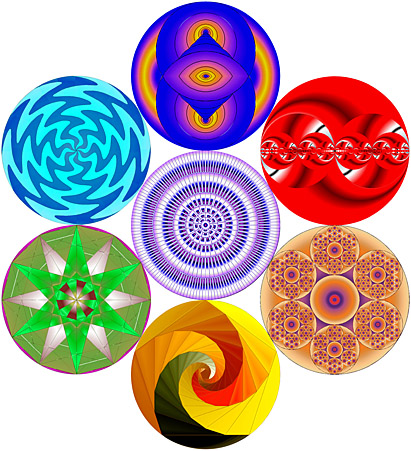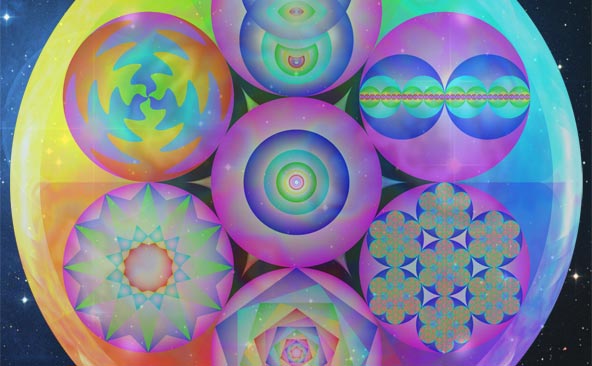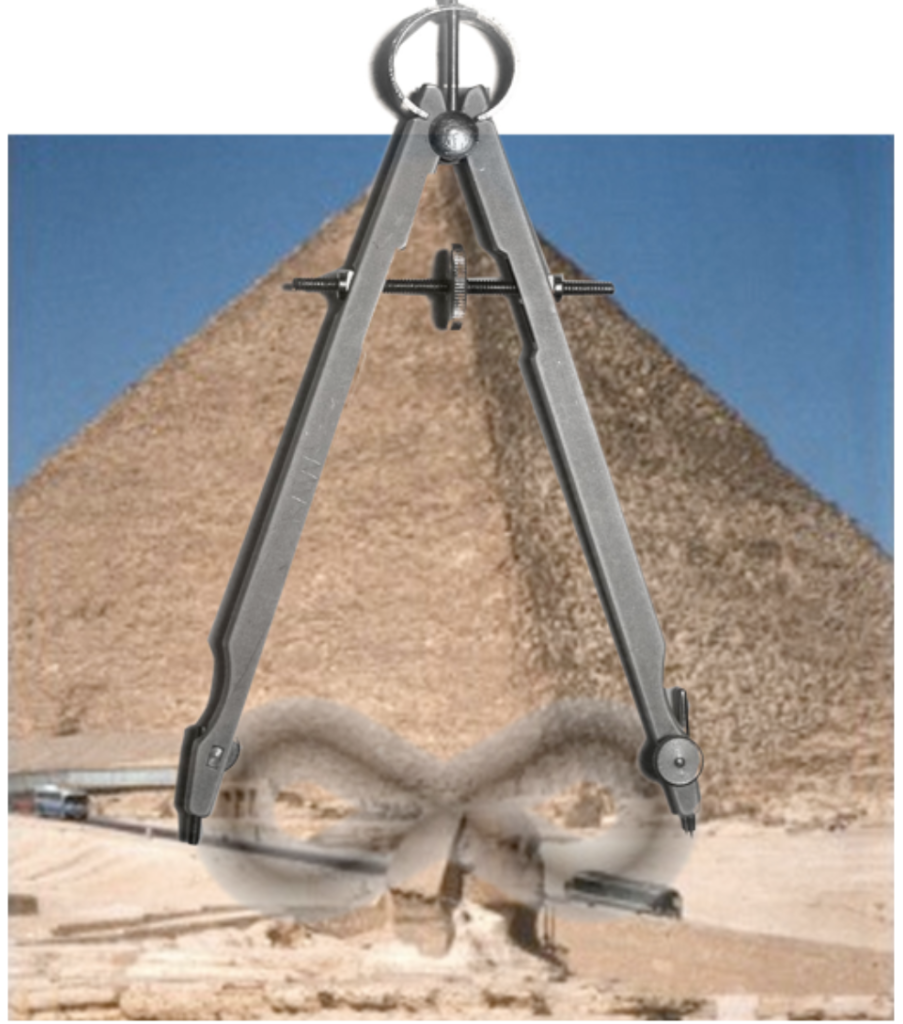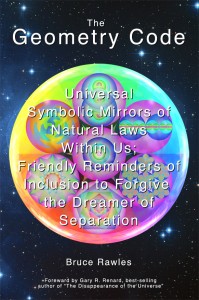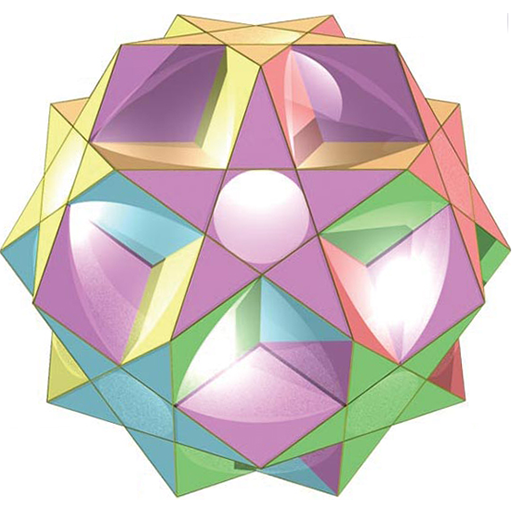The Introduction to this website (Sacred Geometry Introductory Tutorial) begins with a geometric symbol that is perhaps the simplest and yet most profound – the circle. Circular patterns and archetypes appear in countless variations in nature, art, architecture, engineering, and just about every area of life we can imagine. Here are a few familiar examples; I’m sure you can think of countless others, both microscopic, macroscopic (telescopic) and in between, in all dimensions of space, time, metaphor, and thought. We touched on the sphere (Music of the Spheres – The Planets) in a recent post; the 2-dimensional counterpart to the sphere is the ubiquitous circle and provides the foundation for it’s rotation into spheres of any number of dimensions – the quintessential template for polytopes beyond our imagination. Rather than getting boggled or bogged down with those mind-warping ideas, let’s return to the simplicity of the circle.









All of these visual examples are reflections of a form reflecting an ideal; here is what appears in the Introduction to this website (slightly edited from the original):
The Sphere
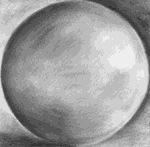
(charcoal sketch of a sphere by Nancy Bolton-Rawles)
Starting with what may be the simplest and most perfect of forms, the sphere is an ultimate expression of unity, completeness, and integrity. No point of view is given greater or lesser importance; all points on the surface are equally accessible and regarded by the center from which all originate. All atoms, cells, seeds, planets, and globular star systems echo the spherical paradigm of total inclusion, acceptance, simultaneous potential and fruition, the macrocosm and microcosm.
The Circle

The circle is a two-dimensional shadow of the sphere, regarded throughout cultural history as an icon of the ineffable oneness; the indivisible fulfillment of the Universe. All other symbols and geometries reflect various aspects of the profound and consummate perfection of the circle, sphere, and other higher dimensional forms of these we might imagine.
The ratio of the circumference of a circle to its diameter, Pi, is the original transcendental and irrational number. (Pi equals about 3.14159265358979323846264338327950288419716939937511…) It cannot be expressed in terms of the ratio of two whole numbers, or in the language of sacred symbolism, the essence of the circle exists in a dimension that transcends linear rationality. Our holistic perspectives, feelings, and intuitions encompass the finite elements of the ideas within them, yet have a greater wisdom than can be expressed by those ideas alone.
When I was writing my first book (Sacred Geometry Design Sourcebook – Universal Dimensional Patterns), the cover art as well as a majority of the 1300 images (including corner “thumbnail” variations) feature circles, either directly or indirectly, so I made a graphical index, rather than a text-oriented one; the dots that dominate the first column (circles and spheres) in these 2 pages hint at the importance of these primal, archetypal, quintessential symbols: circles and spheres.


When I was writing my second book (The Geometry Code: Universal Symbolic Mirrors of Natural Laws Within Us; Friendly Reminders of Inclusion to Forgive the Dreamer of Separation) I also used a “Fruit of Life” symbol (6 circles around an inner circle) to represent the interconnectedness and inseparability of all aspects of what is eternally true, reflected in the 7 Hermetic Laws of antiquity. These 7 circle-framed images (along with the other supporting graphics) are all set within a circle which intuitively reminds us of the infinite and eternal in our minds.
On page 62 of the Geometry Code book, I shared an idea that I find increasingly more helpful in both pragmatic and profound ways. Here is the graphic and supporting text for this portion of the chapter “Mentalism: 1st of the 7 Hermetic Laws”:
The Wikipedia definition of scapegoat is “Scapegoating is the practice of singling out one child, employee, member of a group of peers, ethnic or religious group, or country for unmerited negative treatment or blame.”

The biblical story of the scapegoat offers a very helpful clue. It employs the symbol of the circle as a mnemonic for practicing inclusion or exclusion. In historic accounts, the guilt (sins) of the community were projected onto a goat, which was then banished to the realms outside the inner flock – peripheral to the circle of what we’re willing to accept or allow in our minds. Everything within the circle is OK (innocent as lambs), and if you’re outside, tough luck, goat! The problem is that the very premise that divides wholeness into parts is flawed, and even the ‘good’ that remains begins to be suspect because of the inherent lack of trust. The circle closes in and eventually strangles the dualis- tic split mind into oblivion; it becomes a singularity and winks out; but not without a lot of grief and struggle!
Seeing ‘others’ as ‘out there’ throws away the gifts they bring to us each ʻpresentʼ moment that we lucidly bring their symbolic contribution as mirrors of self back into mind. This works for both seemingly positive and negative experiences, until ultimately we realize that any so-called good experience (e.g. pleasure) in the world is no better or worse than any so-called bad experience (e.g. pain) in the world, because those experiences are all projections of a massive dream that we’ve made up to reinforce the belief in separation. Ego can use any excuse to squander the gifts by assigning ‘otherness’ to others and losing the meaning that the intrinsic connection – always in mind – can bring.
Sometimes it’s blatant when we intentionally erect an inner wall and make a fence around those we ‘like’ or agree with and those we’re not so fond of. This has nothing to do with behavior since it would be impossible to physically assist or care for everybody (let alone all the animal, vegetable, and mineral ‘life’ on just this third spheroid helically spinning around our favorite star). However, it has everything to do with inwardly caring for all, equally. This is an egalitarian ideal we probably all pay lip service to in various ways, but then often find ourselves annoyed with certain ‘others’ or internally profiling a group (whether a species, family, region, nation, or galaxy) and then suddenly – Whoops! – there’s that nasty we/they paradigm in action again, begging for our self-forgiveness.
The profound helpfulness of these circle symbols is evident when we consider that a circle of infinite scope – total inclusion – has no one left out, no one excluded, no one denied, and all equally vital to the whole; each mind embracing this idea IS the whole seen holographically. When, on the other hand, we go with the polarizing default of inner/outer, we/they, us/them, no matter where the line is drawn – or whatever shape, for that matter, a circle is just a placeholder for any exclusionary perspective – we’re always at war with the alleged other in our mind. No peace is possible when the foundation for peace (total inclusion) is denied.
The pragmatic benefit of identifying with the “infinite circle” that includes all of us is that – with considerable practice! – we can train our minds to realize that we can truly afford to “Be kind, for everyone you meet is fighting a hard battle.” Even if there’s no instant transformation/manifestation in the surreal world of our space-time dreams, there is always an opportunity to forgive ourselves for dreaming of separation by seeing our shared interest of peace and benefitting from a tranquil mind in the process, regardless of what seems to be happening around us!
Since (in the USA at least) this is an election year, I try to remind myself that we only get to vote every year or so, but we vote for either the infinite (transpersonal) circle of embracing everyone in our gracious consideration – or the finite polarizing (personal) circle which leaves some out; our scapegoats outside the circle become our projected “goat-scape” yet the problem of our dualistic dueling dream has never left our mind.
